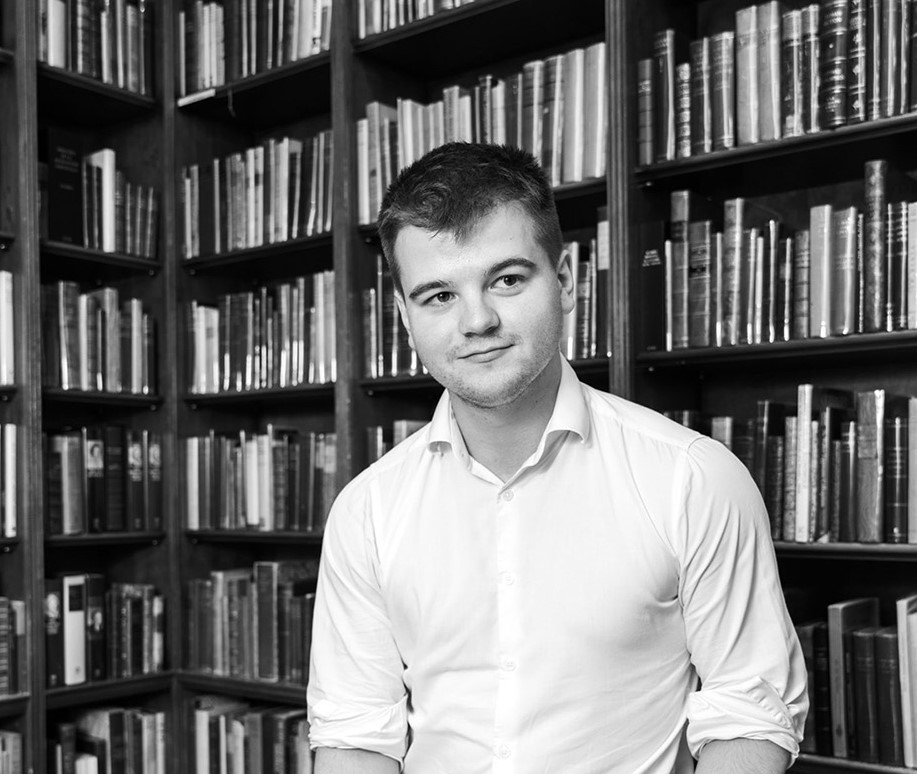The latest in our The Booksellers series, our cataloguer Callum Hill shares his journey into the rare book world, his interest in modern literature, and some of his favourite experiences working at Peter Harrington Rare Books.
How did you find yourself working in the rare books trade?
Luck! I’m not one of those people who always wanted to be a bookseller, but I’ve always loved reading. I studied English at university, and during my master’s I found myself thinking and writing more and more about book history. I got to know enough about it that, when a friend sent me a listing for a job at Peter Harrington, I had enough confidence to think I might be able to do it. I was straight out of uni, and I didn’t really know anything about rare books, so I got unbelievably lucky.
I started in January 2021, the same day we were thrown into another lockdown. I don’t remember everything about that time, but I remember the books. One of the first things I catalogued was a small pile of pamphlets by Virginia Woolf, and one of them was signed by her. I still remember the thrill that gave me.
What is it about rare books that excites you?
I think a lot of the excitement is in the authenticity. There’s something about handling a signed copy of something and thinking – knowing – that the book you hold in your hands was once held in the author’s hands. And if the book is a first edition in fine condition, it looks and feels the way it did the first time it came into the world. It lets you understand the feeling, the what-is-it-like-ness, the experience of the book as an object. In a way, it takes you there, to the moment when it was new. Even when it’s passed through collections over the years, it gives you something of that first-hand knowledge.
But for me, the most exciting books are the ones with a story – an inscription or an association that hints at a friendship or relationship between two writers, or between a writer and a reader. They’re the books I love to write about.
I’ll give you one example. Earlier this year, we had a copy of Belcaro, a book of essays on art by Vernon Lee (the pen name of Violet Paget). The book is dedicated to her lover, the poet A. Mary F. Robinson, and the first chapter takes the form of a love letter from Lee to Robinson, offering a copy of the book to her, like an old-style dedicatory epistle.
Now, in that letter Lee writes things to Robinson that make you feel – in Emily Dickinson’s phrase – as if the top of your head has come off: “I wish I could give you what I have written in the same complete way that a painter would give you one of his sketches; that a singer, singing to you alone, might give you his voice and his art; for a dedication is but a drop of ink on a large white sheet, and conveys but a sorry notion of property. Now, this book is intended to be really yours; yours in the sense that, were it impossible for more than one copy of it to exist, that one copy I should certainly give to you”. It’s as if she’s written, “there is only one copy of this book that matters, this one”. And we had that copy, the dedication copy, which Lee inscribed and presented to Robinson. I still think that’s incredible.
What’s your specialism at Peter Harrington?
I specialize in literature. In practice, this means mostly 20th-century books – modern literature is my bread and butter – but I also work with a good amount of earlier material, as well as manuscripts, letters, photographs, sketches.
What are some of the most interesting books you’ve catalogued?
There are some that leave a deep impression. One was a first edition of the Völsunga Saga, a collection of Icelandic epics translated by William Morris. It’s a gorgeous book, the covers designed by Morris and Philip Webb – and this copy was inscribed by Morris to his fellow Pre-Raphaelite, Algernon Charles Swinburne. Another was a book of war poems given to Siegfried Sassoon by his second-in-command, while they were still in the trenches in northeast France in 1918. It was an incredibly evocative thing.
The most interesting, though, was a copy of a beautiful edition of Whitman’s Song of Myself, printed by the Roycrofters, a socialist artisan community in upstate New York, and presented by the publisher to Whitman’s friend and, possibly, his lover, Edward Carpenter.
It’s a superb association. Carpenter was a philosopher, a socialist, and an early 20th-century prophet of gay rights in Britain. When he was young, he struck up a correspondence with Whitman, and travelled across the Atlantic to meet the poet in 1877. The two had written to one another about “the love of men”, and it’s rumoured that, when they met, they began an affair. Carpenter told the story to another of his lovers, Gavin Arthur, who wrote it all down in the 1960s. You can say it’s only whispers, but until then it was the sort of thing that could only be whispered about. You’ll never read about it in any biography of Whitman, but I believe every word of it.
And if you could have any book in stock for yourself, what would it be?
It has to be poetry, and for me at the moment it would be a first edition of Keats’s Poems (1817), his first book. We currently have a copy from the library of Robert Calder Campbell, a soldier-poet who introduced Keats’s poetry to Dante Gabriel Rossetti, who in turn developed something of a cult of Keats among the Pre-Raphaelites. That or his next book, Endymion, finely bound by Riviere & Son: a thing of beauty and a joy forever.

What lessons have you learnt working as a cataloguer and bookseller?
I’ve learnt a lot, but I think the most important thing is this: if you’re interested or excited or enthusiastic about a book, if you love it and if you can put it into words, someone out there will love it too. It comes through in your writing and you can’t help it. For me, that’s what it’s all about.





